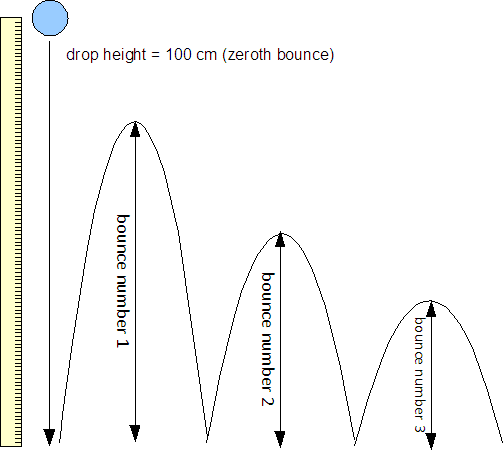
A diagram of the first three bounces of a ball
This laboratory is effectively a practical examination laboratory. In this laboratory I intentionally provide considerably less guidance on the specifics of the chart type and analysis.

A diagram of the first three bounces of a ball
Question: If the ball is always dropped from 100 cm, is there a mathematical relationship between the bounce number and the bounce height for that bounce?
The ball will always be dropped from a height of one hundred centimeters (one meter). This height is called "bounce number zero." Measure the height of the first bounce five times. Repeat for the height of the second bounce, third bounce, fourth bounce, and so forth up to the tenth bounce.
Measure the bounce heights in centimeters.
| Bounce number [x] | Bounce height (cm) | Mean bounce height(cm) [y] | ||||
|---|---|---|---|---|---|---|
| 0 | 100 | 100 | 100 | 100 | 100 | 100 |
| 1 | ||||||
| 2 | ||||||
| 3 | ||||||
| 4 | ||||||
| 5 | ||||||
| 6 | ||||||
| 7 | ||||||
| 8 | ||||||
| 9 | ||||||
| 10 | ||||||
Make a graph using an appropriate graph type to display the mathematical relationship, if any, between the bounce number x and the mean height of that bounce y.
The analysis should include answers to the following questions. Do not simply answer "yes" or "no." Write out your analysis using complete sentences. The format can be either a bulleted list or a paragraph.
As you work on the data and the graphs, work with your lab partners and other classmates. Discuss the ideas that you have. Get together and share ideas.
Wrap up with a conclusion that discusses whether there is a mathematical relationship and, if so, then the nature of that relationship. As a guide to your discussion of the results consider the following questions:
Write well. Grammar, vocabulary, organization, and cohesion will still be marked.